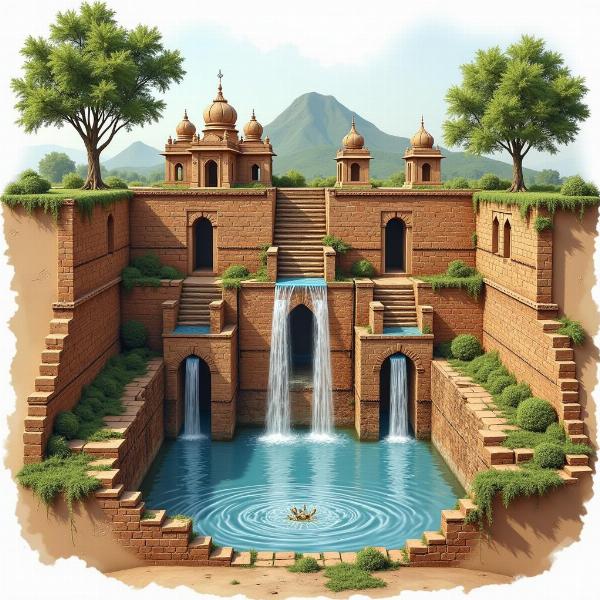Stepwells, magnificent structures that showcase India’s ingenuity and rich cultural history, hold a significant place in the country’s architectural landscape. Understanding the “stepwells meaning in Hindi” opens a window into a world where functionality meets artistry, and where ancient water management systems intertwined with social and religious practices. This article explores the various aspects of stepwells, their historical context, regional variations, and the diverse terms used to describe them in Hindi.
Understanding the Term “Stepwell” in Hindi
The most common Hindi word for stepwell is baoli (बावड़ी) or vav (वाव). Other terms include kundi (कुंडी), often used for smaller stepwells, and jhalra (झालरा), particularly prevalent in Rajasthan. These structures, essentially wells with steps leading down to the water, served as vital water sources, especially in arid and semi-arid regions. They not only provided water for daily needs but also served as cool retreats during scorching summers and spaces for social gatherings and religious ceremonies.
The Historical and Cultural Significance of Stepwells
Stepwells in India date back centuries, with some of the earliest examples found during the Indus Valley Civilization. Their construction flourished during medieval times, particularly under various Rajput kingdoms. These structures were not merely utilitarian; they were often adorned with intricate carvings, sculptures, and pavilions, reflecting the artistic sensibilities of the era. They were integrated into the social fabric of communities, serving as venues for festivals, performances, and everyday interactions.
Regional Variations in Stepwell Architecture
Across different regions of India, stepwells exhibit unique architectural styles and features. In Gujarat, the vavs are often characterized by elaborate ornamentation and multiple storeys. Rajasthan’s baolis are known for their grandeur and the use of local sandstone. The kunds of southern India, while simpler in design, still display distinct regional characteristics. These variations highlight the adaptability of the stepwell concept to different geographical and cultural contexts.
Stepwells and Water Management in Ancient India
 Ancient Water Management Systems using Stepwells
Ancient Water Management Systems using Stepwells
Stepwells played a crucial role in water harvesting and conservation. They were designed to capture rainwater and recharge groundwater aquifers. The stepped architecture allowed people to access the water level as it fluctuated throughout the year. This ingenious system ensured a reliable water supply even during periods of drought and scarcity.
Preserving India’s Stepwell Heritage
Today, many stepwells face neglect and deterioration. Efforts are underway to restore and conserve these architectural marvels, recognizing their historical, cultural, and ecological importance. Raising awareness about their significance and promoting sustainable tourism can help protect these unique structures for future generations.
Why are Stepwells Important Today?
Even in modern India, stepwells hold valuable lessons in sustainable water management. Their design principles can be adapted to contemporary water harvesting techniques. Moreover, their potential as community spaces and tourist attractions can contribute to local economies and cultural preservation.
Conclusion
The “stepwells meaning in Hindi” encompasses much more than just a translation. It represents a rich tapestry of history, architecture, and cultural significance. From the baolis of Rajasthan to the vavs of Gujarat, these structures stand as testaments to India’s ingenuity and its deep-rooted connection with water. Preserving these architectural wonders is crucial for understanding our past and building a sustainable future.
FAQ
-
What is the difference between a baoli and a vav? While both terms refer to stepwells, “vav” is more commonly used in Gujarat, while “baoli” is prevalent in other regions, especially Rajasthan.
-
Are stepwells still used today? Some stepwells continue to be used as water sources, while others have been restored as tourist attractions or community spaces.
-
What is the significance of stepwells in Indian culture? Stepwells were not just water sources but also social hubs and spaces for religious rituals. Their architecture often reflected the artistic sensibilities of the time.
-
How can I contribute to the preservation of stepwells? Supporting restoration efforts, promoting responsible tourism, and raising awareness about their importance are ways to contribute.
-
Where can I find the most famous stepwells in India? Rajasthan and Gujarat are home to some of the most renowned stepwells, including Chand Baori in Abhaneri and Rani ki Vav in Patan.
-
What is the oldest stepwell in India? Some of the earliest examples of stepwells are believed to date back to the Indus Valley Civilization.
-
What are the architectural features of a stepwell? Stepwells typically consist of a series of steps leading down to a well, often with pavilions, platforms, and intricate carvings.
You Might Also Be Interested In:
pools meaning in hindi, aridity meaning in hindi, fountain in hindi meaning, anavrishti meaning in hindi
About Meaning-Hindi.in
Meaning-Hindi.in is your trusted partner for professional Hindi translation services. We offer a comprehensive range of solutions, from business and legal document translation to website localization and technical manuals. Our expert team ensures accurate and culturally sensitive translations for diverse industries, including educational and academic materials, delivering fast and specialized services. Contact us today to discuss your translation needs! Email: [email protected], Phone: +91 11-4502-7584.